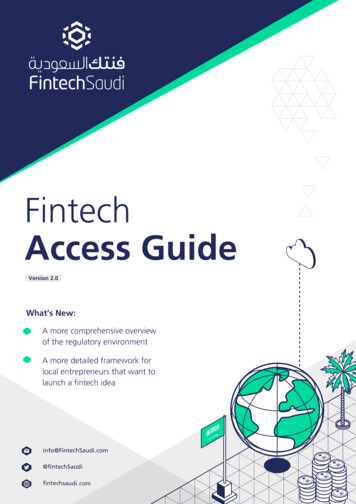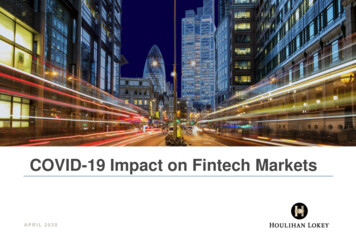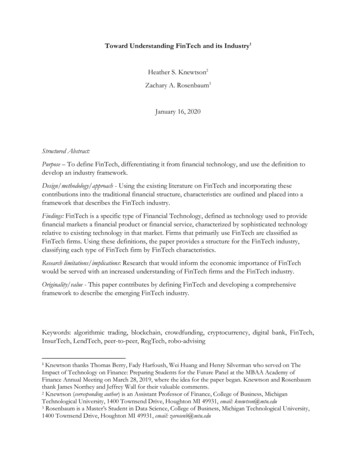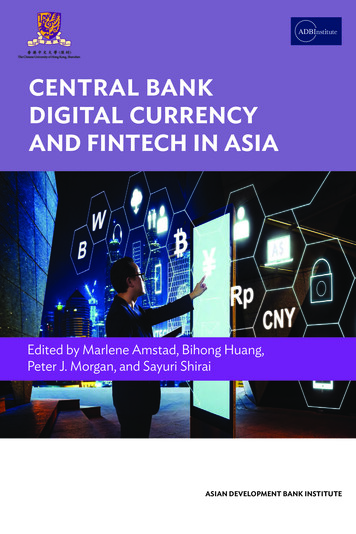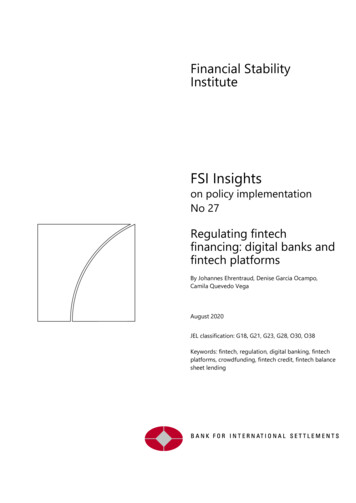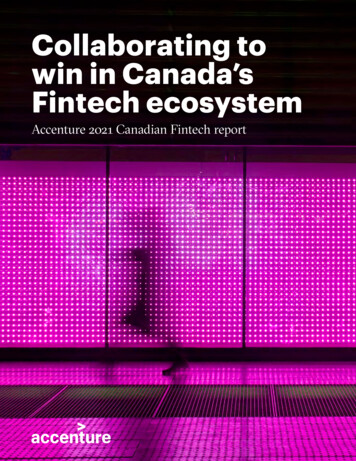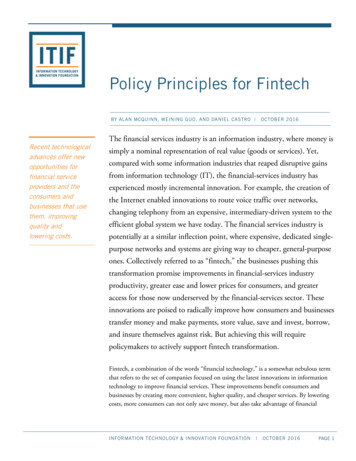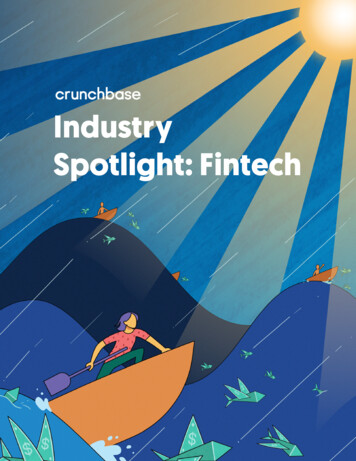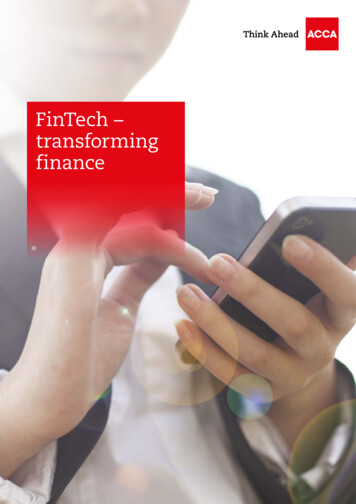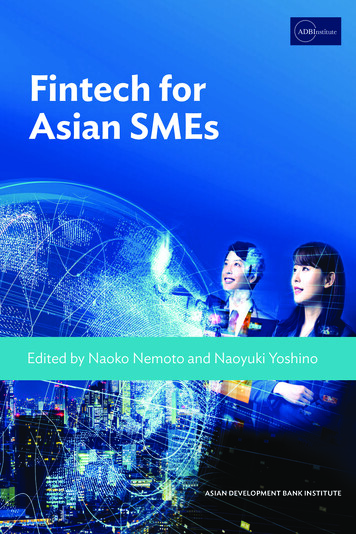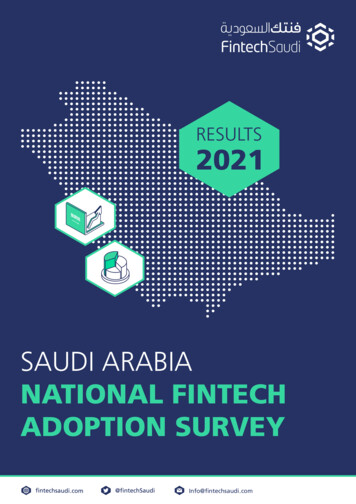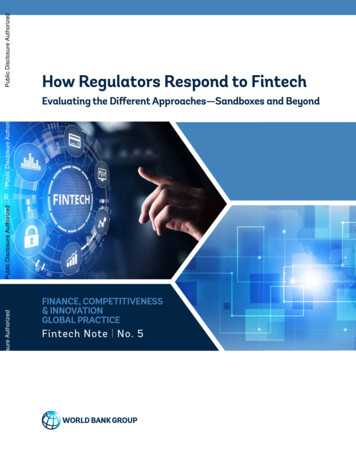
Transcription
Public Disclosure AuthorizedHow Regulators Respond to FintechPublic Disclosure AuthorizedPublic Disclosure AuthorizedPublic Disclosure AuthorizedEvaluating the Different Approaches—Sandboxes and BeyondFINANCE, COMPETITIVENESS& INNOVATIONGLOBAL PRACTICEFintech Note No. 5
2020 International Bank for Reconstruction and DevelopmentThe World Bank Group1818 H Street NW Washington DC 20433Telephone: 202-473-1000Internet: www.worldbank.orgDisclaimerThis work is a product of the staff of The World Bank with external contributions. The findings, interpretations, and conclusions expressed in this work do not necessarily reflect the views of The World Bank, its Board of Executive Directors,or the governments they represent.The World Bank does not guarantee the accuracy of the data included in this work. The boundaries, colors, denominations, and other information shown on any map in this work do not imply any judgment on the part of The World Bankconcerning the legal status of any territory or the endorsement or acceptance of such boundaries.Rights and PermissionsThe material in this work is subject to copyright. Because the World Bank encourages dissemination of its knowledge,this work may be reproduced, in whole or in part, for noncommercial purposes as long as full attribution to this work isgiven.Any queries on rights and licenses, including subsidiary rights, should be addressed to the Office of the Publisher, TheWorld Bank, 1818 H Street NW, Washington, DC 20433, USA; fax: 202-522-2422; e-mail: pubrights@worldbank.org.Photo Credits: World Bank Photo Library and Shutterstock
Table of ContentsAcknowledgmentsiiiGlossaryivAbbreviations and AcronymsviExecutive SummaryixI. Introduction1II. Challenges in regulating Fintech3III. The Different Regulatory Approaches7Regulatory Approach 1: “Wait-and-See”10Regulatory Approach 2: “Test-and-Learn”11Regulatory Approach 3: Innovation Facilitators14Innovation Hubs15Regulatory Sandboxes19Regulatory Accelerators or Regtech Labs25Regulatory Approach 4: Regulatory Laws and Reforms29IV. Evaluating the Right Regulatory Approach33V. Guidance for Policymakers & Conclusion37Annex 1: Elements of the Bali Fintech Agenda43Annex 2: List of Innovation Facilitators45Endnotes51TABLE OF CONTENTSI
AcknowledgmentsThis discussion note is a product of the Financial Inclusion, Infrastructure & Access Unit inthe World Bank Group’s Finance, Competitiveness & Innovation Global Practice.This note was prepared by Sharmista Appaya (Senior Financial Sector Specialist & TaskTeam Leader) and Helen Luskin Gradstein (Financial Sector Specialist). The paper benefitted by inputs from Dorothee Delort (Senior Financial Sector Specialist) and ThervinaMathurin-Andrew (Ministry of Finance, St Lucia), and was supported by Renuka Pai(Analyst Consultant). Mahesh Uttamchandani and Alfonso Garcia Mora provided overallguidance. The team is grateful for the substantive feedback received from peer reviewers Harish Natarajan, Ana Fiorella Carvajal, Pierre-Laurent Chatain and Ivo Jenik. Theteam thanks Naylor Design, Inc. for design and layout assistance.The findings, interpretations, and conclusions expressed in the paper and case studiesare entirely those of the authors. They do not necessarily represent the views of theWorld Bank Group and its affiliated organizations or those of the Executive Directors ofthe World Bank or the governments they represent.ACKNOWLEDGMENTSIII
GlossaryAlternative Credit Scoring is defined as non-traditional models of assessing credit risk usingmachine learning and algorithms based on big data mining.1Anti-money laundering and countering the financing of terrorism (AML/CFT) measuresare defined by the Financial Action Task Force (FATF), the international standard setter in thisarea. The BCBS regularly issues guidance to facilitate banks’ compliance with their obligationsin this area.Artificial Intelligence (AI) is defined as IT systems that perform functions requiring humancapabilities. AI can ask questions, discover and test hypotheses, and make decisions automatically based on advanced analytics operating on extensive data sets. Machine learning (ML) isone subcategory of AI.2Big data designates the large volume of data that can be generated, analyzed and increasingly used by digital tools and information systems. This capability is driven by the increasedavailability of structured data, the ability to process unstructured data, increased data storagecapabilities and advances in computing power.Crowdfunding is the practice of funding a project or venture by raising monetary contributionsfrom a large number of people. It is often performed today via internet-mediated registriesthat facilitate money collection for the borrower (lending) or issuer (equity).3Distributed ledger technology (DLT) such as blockchain are a means of recording information through a distributed ledger, i.e. a repeated digital copy of data at multiple locations.These technologies enable nodes in a network to securely propose, validate and record statechanges (or updates) to a synchronised ledger that is distributed across the network’s nodes.4Fintech Ecosystem is made up of consumers, financial institutions, Fintech start-ups, investors,regulators and educational institutions and aims to provide mutually beneficial cooperationamong stakeholders, to help deliver financial services at lower cost, higher speed and at betterquality to more consumers.5Fintech refers to the advances in technology that have the potential to transform the provision of financial services spurring the development of new business models, applications,processes, and products.6Innovation Facilitator are public sector initiatives to engage with the Fintech sector, such asRegulatory Sandboxes, Innovation Hubs and Innovation Accelerators.7Innovation Hub/Office refers to an Innovation Facilitator set up by a supervisory agency thatprovides support, advice or guidance to regulated or unregulated firms in navigating theregulatory framework or identifying supervisory policy or legal issues and concerns. Unregulated entities can engage with regulators to discuss Fintech-related issues (share informationand views etc.) and seek clarification on the conformity with the regulatory framework and/orlicensing requirements.IVGLOSSARY
Machine Learning (ML) is a method of designing problem-solving rules that improve automatically through experience. Machine-learning algorithms give computers the ability to learnwithout specifying all the knowledge a computer would need to perform the desired task, aswell as study and build algorithms that can learn from and make predictions based on dataand experience.8New entrant refers to a prospective financial services provider that has not been authorized bythe regulator yet.No enforcement action letters provide assurance to a firm that the regulator would not takeenforcement action against them, so long as they comply with the conditions specified in theletter.Peer-to-peer (P2P) lending refers to direct lending from savers to borrowers—traditionally theplatform avoids intermediation by banks but also do not bear the risk of default.9Regtech refers to a regulatory technology or Regtech involves new technologies to help regulated financial service providers streamline audit, compliance and risk management and otherback office functions to enhance productivity, and overcome regulatory challenges, such as therisks and costs related to regulatory reporting and compliance obligations. This can also referto firms that offer such applications.Regulatory Accelerator or Regtech Lab refers to a partnership arrangement between Fintech providers and central banks/supervisory agencies to ‘accelerate’ growth or develop usecases, such as suptech or regtech, which may involve funding and/or authorities’ endorsement/approval for future use in central banking operations or in the conduct of supervisory tasks.Regulatory exemptions or waivers exempt a firm from requiring authorization to carry out aregulated activity or compliance with a specific requirement.Regulatory Sandbox is a controlled, time-bound, live testing environment, which may feature regulatory forbearance and alleviation through discretions. The testing environment mayinvolve limits or parameters within which the firms must operate.Restricted or temporary licenses can give a firms a license but set limitations on their authorization for example, the type of service that can be provided or the number of customers thatcan be served or the time validity of the license.Suptech is the use of innovative technology by supervisory agencies to support supervision. Itis intended to help supervisory agencies to digitize (in the main) reporting and regulatory processes, resulting in more efficient and proactive monitoring of risk and compliance at financialinstitutions.10GLOSSARYV
Abbreviationsand AcronymsVIACPRAutorite de Controle Prudentiel, FranceADGMAbu Dhabi Global MarketAIArtificial IntelligenceAMFAutorite des Marches Financiers, FranceAMLAnti- Money LaunderingAPIApplication Programming InterfaceASEANAssociation of Southeast Asian NationsASICAustralian Securities and Investment CommissionBCBSBasel Committee for Banking SupervisionBFABali Fintech AgendaBISBank of International SettlementsBNMBank Negara MalaysiaBNRNational Bank of RwandaBoEBank of EnglandBOTBank of ThailandBSPBangko Sentral ng PilipinasCBKCentral Bank of KenyaCDDCustomer Due DiligenceCFPBConsumer Financial Protection BureauCFTCombating the Financing of TerrorismCFTCCommodities and Futures Trading CommissionCGAPConsultative Group to Assist the PoorCMACapital Markets Authority (Kenya)CNBVComisión Nacional Bancaria y de Valores, MexicoCPMICommittee on Payments and Market InfrastructuresDFSDigital Financial ServicesDIFCDubai International Financial CentreDLTDistributed Ledger TechnologyECEuropean CommissionEMDEEmerging Markets and Developing EconomiesACRONYMS AND ABBREVIATIONS
EUEuropean UnionFATFFinancial Action Task ForceFCAFinancial Conduct AuthorityFINMASwiss Financial Market Supervisory AuthorityFSBFinancial Stability BoardGDPRGeneral Data Protection RegulationGPFIGlobal Partnership for Financial InclusionGSMAGroupe Spéciale Mobile AssociationHKMAHong Kong Monetary AuthorityIAISInternational Association of Insurance SupervisorsICOInitial Coin OfferingIDBInter-American Development BankIFCInternational Finance CorporationIMFInternational Monetary FundIOSCOInternational Organization of Securities CommissionsIRDAIInsurance Regulatory and Development Authority of IndiaJFSAJapan Financial Services AgencyKPMGKlynveld Peat Marwick GoerdelerLACLatin America and the CaribbeanMASMonetary Authority of SingaporeMENAMiddle East North AfricaMNOMobile Network OperatorNBFINon-Bank Financial InstitutionNFISNational Financial Inclusion StrategyNGONon-Governmental OrganizationOCCOffice of Comptroller of the CurrencyOICOffice of Insurance Commission (Thailand)OJKOtoritas Jasa Keuangan (Financial Services Authority of Indonesia)P2PPeer-to-peerPoCProof of ConceptACRONYMS AND ABBREVIATIONSVII
VIIIRBIReserve Bank of IndiaRegtechRegulatory TechnologyRURARwanda Utilities Regulatory AssociationSAMASaudi Arabia Monetary AuthoritySARBSouth African Reserve BankSFCSecurities and Futures Commission of Hong KongSMEMicro, Small-, and Medium-Sized EnterprisesSSBStandard-Setting BodiesSuptechSupervisory TechnologySWIFTSociety for Worldwide Interbank Financial TelecommunicationsUAEUnited Arab EmiratesUFAUniversal Financial AccessUKUnited KingdomUNCDFUnited Nations Capital Development FundUNSGSAUN Secretary-General’s Special Advocate for Inclusive Finance for DevelopmentUSAIDUnited States Agency for International DevelopmentWBGWorld Bank GroupACRONYMS AND ABBREVIATIONS
Executive SummaryTechnology is changing the paradigm of financial services and putting pressure on financial sector authorities: pressure to adapt to innovations already advanced in their market,and pressure to foster financial innovation so that their market doesn’t lag behind peercountries. The past few years have demonstrated that regulations will need to evolveto cover new activities and business models that have been brought about by financialtechnology (Fintech11) as it works to disintermediate the financial services value chain andtransform the landscape as a whole.Digital disruption however is not new, and we have long been able to summon movies,food, cars and flowers at the touch of a button. However, the impact on the financial sector is different, primarily due to a) the knock-on macroeconomic impact it can have onfinancial integrity and stability b) the challenges it poses for regulators and policymakersdue to the lack of reliable data, the unconventional business models and the potentiallegal amendments that might be required and c) the bearing on consumer protection.This makes it vitally important that as policymakers foster an enabling environment, theappropriateness of the financial sector policy framework and the potential risks to statutory objectives are monitored closely and mitigated.12Policymakers, regulators and supervisors13 worldwide are finding themselves in a regulatory dilemma when trying to achieve the right balance between enabling innovativeFintech and safeguarding the financial system.Policy responses seen across jurisdictions to Fintech can be broadly grouped into: (i)applying existing regulatory frameworks to new innovations and their business models,often by focusing on the underlying economic function rather than the entity; (ii) adjustingexisting regulatory frameworks to accommodate new entrants and the re-engineering ofexisting processes to allow adoption of new technologies; and (iii) creating new regulatory frameworks or regulations to include (or prohibit) Fintech activities. To support thedevelopment of an appropriate legal, regulatory and supervisory framework around thethree policy responses, countries have been exploring different regulatory approachesand initiatives designed to promote innovation and experimentation. This paper exploresthose regulatory approaches in some detail.Regulatory approaches can be applied either in combination or solely and are not mutually exclusive. We have classified them into four regulatory approach categories (a) “Wait& See”, (b) “Test & Learn”, (c) Innovation Facilitators (including Sandboxes) and lastly(d) Regulatory Laws and Reform. They are often adopted in areas where the regulatoryframework is either unclear or where there are gaps, or to specifically support a statutoryEXECUTIVE SUMMARYIX
objective with the aim of implementing an enabling environment for Fintech. It is then the outcomes and lessonsdistilled from the use of approaches and the associatedregulatory tools that will help define a regulatory responsefor the country (i.e. regulatory reforms).When deciding which approach or sequence of approaches to adopt in order to inform subsequent policy responses, there are a number of considerations that need tobe made by the policymaker such as the objectives theyare trying to achieve, how Fintech plays into the overarching strategy for the country, considerations of thecritical success factors, and importantly, the country circumstance. Undertaking an assessment of the landscapewhile taking into consideration the country context, is anecessary first step for all regulators prior to selecting anapproach to Fintech.Of the approaches described above, the Regulatory Sandbox14 has been garnering substantial attention. Accordingto the Global Fintech Survey (GFS),15,16 it was found thatwhile the Regulatory Sandbox was a common responseadopted by policymakers, there is insufficient evidence toclaim that it is the most effective. The GFS of country Fintech experiences conducted in 2019 as part of the WBGIMF Bali Fintech Agenda gathered responses from nearlya hundred countries. Of those surveyed, it was identifiedthat nearly thirty-three Sandboxes have been initiatedsince 2016, bringing the total number of Sandboxes globally to over 6017 at last count.Other Innovation Facilitators, however, such as FintechAccelerators and Innovation Hubs which have been usedinstead of, or as a complement to, a Regulatory Sandboxhave shown promise of being more effective and suitableto business needs. Innovation Hubs or Offices in particular are often seen as the first step along a regulatory journey—providing support, advice, guidance and even, insome cases, physical office space, to either regulated orunregulated firms to help them identify opportunities forgrowth, and navigate the regulatory, supervisory, policy orlegal environment. Results however, are still developing,and it is too early to draw a definitive conclusion on theoutcomes.FIGURE 1: Factors to Consider Before Evaluating a Regulatory ApproachLegalmandateMarketconditionsXHow well established is the legal and regulatory framework?What powers are afforded to the regulator by the mandate under which it operates?Is it a rules-based or principles-based regulatory framework?How competitive is the market?Number of entities excluded/underserved and MSMEsNumber and types of financial institutionsStakeholderecosystemHow many regulators oversee financial supervision?Capacity andresourcesHow much resources—both financial and human—does theregulator have available?Maturity ofthe FintechsegmentMaturity of the players in the marketCoordination with technology regulatorsRelationship between incumbents and FintechsOther players such as industry accelerations, VC funds etc.HOW REGULATORS RESPOND TO FINTECH: EVALUATING THE DIFFERENT APPROACHES—SANDBOXES AND BEYOND
In order for Fintech to thrive a multi-dimensional approachneeds to be adopted. Our experience has revealed thata detailed review of existing laws and regulations, combined with a defined means of communication with theregulator (such as an innovation office to serve as point ofcontact) and in suitable cases a “test-and-learn” methodology which could potentially result in regulatory reformhas worked best. This requires an in-depth consideration ofregulatory framework and constantly fine-tuning it to suitthe changing environment and emerging business models.financial sector moves on from bilateral to networkedbusiness models, so too must international institutionsand domestic authorities enhance mechanisms throughwhich to co-innovate, share experience and coordinateefforts to promote an orderly adoption and integration of innovation. The healthy development of such anecosystem will result in mutually beneficial cooperationamong stakeholders, and eventually, help financial services be delivered at lower cost, higher speed and atbetter quality to more consumers.In parallel, policymakers should engage with the broaderecosystem such as enabling infrastructure and platforms—such as interoperability and the developmentof data repositories- needed to support Fintech. Witha growing digital economy, the role and importanceof information and cybersecurity also increases, adding security functions to protect critical informationand infrastructure. Adaptation of policy, legal and institutional contexts should be complemented by knowledge exchange. The interdependence of our financialsystems demand that we collectively strengthen ourefforts in knowledge sharing and coordination. As theAs this emerging field develops, supervisory authoritiesmight need to be granted enough power and resources toexercise effective, flexible and principles-based prudentialsupervision. However regulatory approaches should notbe a substitute for building effective, permanent regulatory and legal frameworks that may eventually need to beestablished to create transformational change.This paper provides an overview of different regulatoryapproaches to Fintech, discusses their pros and consusing country case studies where appropriate, while providing high-level guidance and allowing policymakers todraw from lessons and learnings across the globe.FIGURE 2: Process to Identify Regulatory Approaches and Policy Responses Towards FintechTIPS FOR SUCCESS1. Define objectivesand policy priorities6. ImplementpolicyresponseEngage early and often with the marketGet ExecutiveLevel SponsorshipGauge Preparedness to offer Regulatory ReliefFacilitate interagency coordination and collaborationIdentify KPIsFocus on principles not rulesCommunication with the market2. Assess conditionsand feasibilityLegal and Regulatory FrameworkRisks and CapacityMaturity of FinTech SegmentMarket ConditionsStakeholder EcosystemPOLICY RESPONSES1. Apply existing regulatoryframework2. Adjust existing regulatoryframework3. Create new regulatoryframework3. Identifyrisks5. Measureoutcomes4. SelectregulatoryapproachREGULATORY APPROACHESWait and SeeTest and LearnInnovation FacilitatorsNew Regulatory ReformEXECUTIVE SUMMARYXI
IINTRODUCTIONTechnology enabled innovation in financial services are fast reshaping economic andfinancial landscape—promising customer-centric products and services, delivered withresilience, diversity and depth. Fintech has the potential to significantly disrupt the traditional business model of financial institutions by enhancing efficiencies, reducing costsand expanding access to financial services. While presenting opportunities, Fintech alsopresents risks at both the macro and micro levels.Digital disruption however is not new, and we have long been able to summon movies,food, cars and flowers at the touch of a button. However, the impact on the financialsector is different, primarily due to a) the macroeconomic impact it can have on financialintegrity and stability, b) the challenges it poses for regulators and policymakers and thepotential legal amendments that might be required and c) the risks towards consumers.This makes it vitally important that as policymakers foster an enabling environment,21 thefinancial sector policy framework and the potential risks to statutory objectives are monitored closely and mitigated.BOX 1Potential Impacts of Fintech on Financial InclusionFinancial inclusion is one of critical drivers of poverty reduction and economicgrowth in emerging markets and developing economies as identified by the G20.Currently, an estimated 1.7 billion adults globally lack access to a transactionaccount and are excluded from the formal financial system.18 While there havebeen tremendous gains that have already been achieved in furthering inclusion,the fast-evolving digital economy together with effective supervision—whichmay be digitally enabled- are essential to cross some of the remaining hurdles inachieving financial inclusion.19,20 New technology-enabled financial services suchas peer-to-peer (P2P) lending, crowdfunding, alternative credit scoring, and newforms of savings, remittances and insurance, if properly regulated, can extendthe benefits of financial inclusion to millions of unbanked and underbanked people around the world.INTRODUCTION1
This has led to financial sector policymakers, regulatorsand supervisors22 worldwide finding themselves in a regulatory dilemma when trying to achieve the right balancebetween enabling innovative Fintech and safeguardingthe financial system. Regulators are facing many impediments to striking this balance, and effectively supervisingand regulating emerging innovations remains a challenge.According to the Regulating Alternative Finance23 report,which surveyed 111 jurisdictions, the top four reportedimpediments to effectively supervising emerging innovation include (i) limited technical expertise (65 percent); (ii)limited funding / resources (48 percent); (iii) jurisdictionover the activity is unclear or limited (41 percent); and (iv)need to coordinate the activities of multiple regulators(38 percent).To this end, in response to requests from policymakerskeen to foster Fintech’s potential benefits and to mitigate its possible risks, the WBG and IMF in collaborationdeveloped the “Bali Fintech Agenda” (BFA). As individual countries formulate their policy approaches, the BFAbrings together and advances key issues for policymakers and the international community to consider. It distillsthese considerations into 4 key objectives: Objective 1: Foster enabling environment to harnessopportunities Objective 2: Strengthen financial sector policy framework Objective 3: Address potential risks and improve resilience Objective 4: Promote international collaborationEach of these objectives are further divided into 12 elements arising from the experiences of member countries24(See Annex 1). The paper expands specifically on the BFAElements VI (Adapt Regulatory Framework and Supervisory Practices for Orderly Development and Stability ofthe Financial System) and VII (Modernize Legal Frameworks to Provide an Enabling Legal Landscape) as theyrelate to adaptation of Regulatory Framework, Supervisory Practices and Legal Frameworks.2The report introduces a range of regulatory responsesthat have been used by regulators thus far to engage withFintech and provides guidance for policymakers to understand the benefits and limitations of each, while takinginto context the determinants for their relative appropriateness within jurisdictions. While some Fintech activitiescan often be covered within existing regulatory frameworks, the majority of jurisdictions are taking or planningto take additional regulatory measures to respond toemerging Fintech services, the scope and scale of whichvary substantially including new laws, Innovation Offices,Regulatory Sandboxes and even reskilling to respond totransforming environment.25The various approaches to innovation seen globally havebeen collated into four main categories. The paper offersparticular focus on the roles of Innovation Facilitators (acollective term for Regulatory Sandboxes, RegulatoryAccelerators and Innovation Offices) as novel and prevalent concepts. However, it is important to note that thereis no one size that fits all. Assessment against several criteria including the maturity of the sector, gaps in serviceofferings, robustness of the regulatory framework, trust inthe system, among other considerations, are required inorder to effectively gauge the relative appropriateness ofeach approach within different jurisdictions.This paper is structured to describe the different challenges facing regulators given the rise of Fintech innovations in Section II and the various regulatory approachesbeing taken as a response to emerging innovations inSection III. Sections III also expands on each of the regulatory approaches in turn, and Section IV and V providesguiding considerations to support policymakers evaluating an appropriate regulatory approach for their jurisdiction. Also included are results from the Global FintechSurvey conducted as part of the Bali Fintech Agenda onthe approaches taken by jurisdictions and the WBG-CGAPglobal survey on lessons learnt from existing Sandboxesexperiences. Where possible, the paper includes countryexamples as case studies, these are meant to be for illustrative purposes only and are not displayed as examplesof best practice.HOW REGULATORS RESPOND TO FINTECH: EVALUATING THE DIFFERENT APPROACHES—SANDBOXES AND BEYOND
IICHALLENGES INREGULATINGFINTECHThere has been an increasing number of non-bank financial institutions that have comeinto existence since 2008, and innovation will continue to accelerate. Although there arenumerous benefits that Fintech brings, policymakers need to also be cognizant of therisks to consumers and, more broadly to financial stability and the challenges that regulators face in regulating this, as yet, unfamiliar territory.As the financial system adapts, concerns arise regarding a range of issues, including:consumer and investor protection; the clarity and consistency of regulatory and legalframeworks, and the potential for regulatory arbitrage and contagion; the adequacy ofexisting financial safety nets, including lender-of-last-resort functions of central banks;and potential threats to financial integrity. Moreover, the adoption of Fintech may posetransition challenges, and policy vigilance will be needed to make economies resilientand inclusive, so as to capture the full benefits of this emerging trend.This brings a number of challenges for regulators. One of the most prominent challengesof regulating Fintech is that it blurs international borders and creates borderless platforms. Providers can offer services globally, causing complex transaction monitoring forpublic authorities. This issue is exacerbated as some of the players are outside the scopeof regulation and regulation is not harmonized across borders highlighting the needfor international co-operation. These include services such as crypto-exchanges, peer-topeer lenders and those offered by Big Tech players—like Google, Amazon, Facebook andApple that are entering the realm of financial services.Another important issue that regulators have had to deal with is the increased disintermediation of the value-chain and the bypassing of traditional intermediaries. This isfurther complicated by bringing different sectors from finance and technology togetherwith to telecommunications and infrastructure to compete and collaborate as they provide services. Often sectors fall under the mandate of different regulators and call intoquestion regulators’ assumptions about market participants and practices. The rate ofadoption of Fintech and the potential for players to scale rapidly and the impact this hason the financial system puts further pressure on the regulator to respond rapidly withoutnecessarily having the full picture. Other issues include the lack of reliable informationabout the structure and operations of Fintech markets and the fragmentation of the institutional and supervisory setting.The rapid pace of change necessitates regulators to be agile and adapt to the constantlychanging environment. To do so, policymakers need to understand how to bala
Fintech Ecosystem is made up of consumers, financial institutions, Fintech start-ups, investors, regulators and educational institutions and aims to provide mutually beneficial cooperation among stakeholders, to help deliver financial services at lower cos
